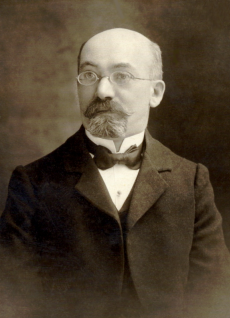
Esperanto is an international auxiliary language, which means that it helps groups of people who don’t speak the same language to communicate. Most languages that people speak in the world today developed naturally over thousands of years, but Esperanto is a constructed language which was deliberately invented. Of all the constructed languages Esperanto is spoken most widely worldwide.
Esperanto was invented by L. L. Zamenhof, a Polish-Jewish eye doctor and surgeon. In 1887 he published a book called Unua Libro under the pseudonym Doktoro Esperanto, or “one who hopes.” Zamenhof himself didn’t actually name his new language, which is why it is named after his pseudonym. In his book Zamenhof set out all the rules for speaking and writing Esperanto, and also explained his reasons for inventing it. Firstly he wanted to help make it easier for people to learn new languages. Esperanto is itself very easy to learn: a university in Germany found that it took French pupils 150 hours to learn it, compared to 1000 to learn Italian, and 2000 to learn German! Learning Esperanto even makes it easier to learn new languages afterwards.
The title Unua Libro means ‘Universal Language’, because Zamenhof wanted Esperanto to be “a means of international communication” allowing people from all different countries to understand each other. Zamenhof grew up in Bialystok which was part of the Russian Empire. In a letter to a friend he described the town as “divided into four distinct elements: Russians, Poles, Germans and Jews; each of these spoke their own language and looked on all the others as enemies.” Upset by the way different languages could separate people, Zamenhof was determined to find a way to overcome the problem.
Esperanto has a 28-letter alphabet based on the Latin script, so it isn’t very different to English. However, some of the letters have diacritics, which are small symbols added above the letter, and there is no q, w, x, or y:
a b c ĉ d e f g ĝ h ĥ i j ĵ k l m n o p r s ŝ t u ŭ v z
The words in Esperanto, or its vocabulary, mostly come from Romance languages like Spanish, French and Portuguese, though some come from German, Greek and Slavic languages. The words are made up of roots which speakers can add different endings, prefixes and suffixes to. Unua Libro listed 900 roots and in 1894 Zamenhof published Universala Vortaro, the first Esperanto dictionary, which added many more. The way new words are made up is always exactly the same, which makes it easy for people to understand new words.
In 1905 the first international meeting for Esperanto speakers was held in Boulogne-sur-Mer, France. Since then a world congress has been held every year, and is attended by 2000 people on average. Zamenhof’s dream that everyone in the world would speak Esperanto hasn’t come true, but the language has spread a remarkable amount. The database Ethnologue estimates that up to two million people worldwide speak at least a bit of Esperanto, and this number is growing all the time!
Image: Wikipedia commons

0 Comment:
Be the first one to comment on this article.